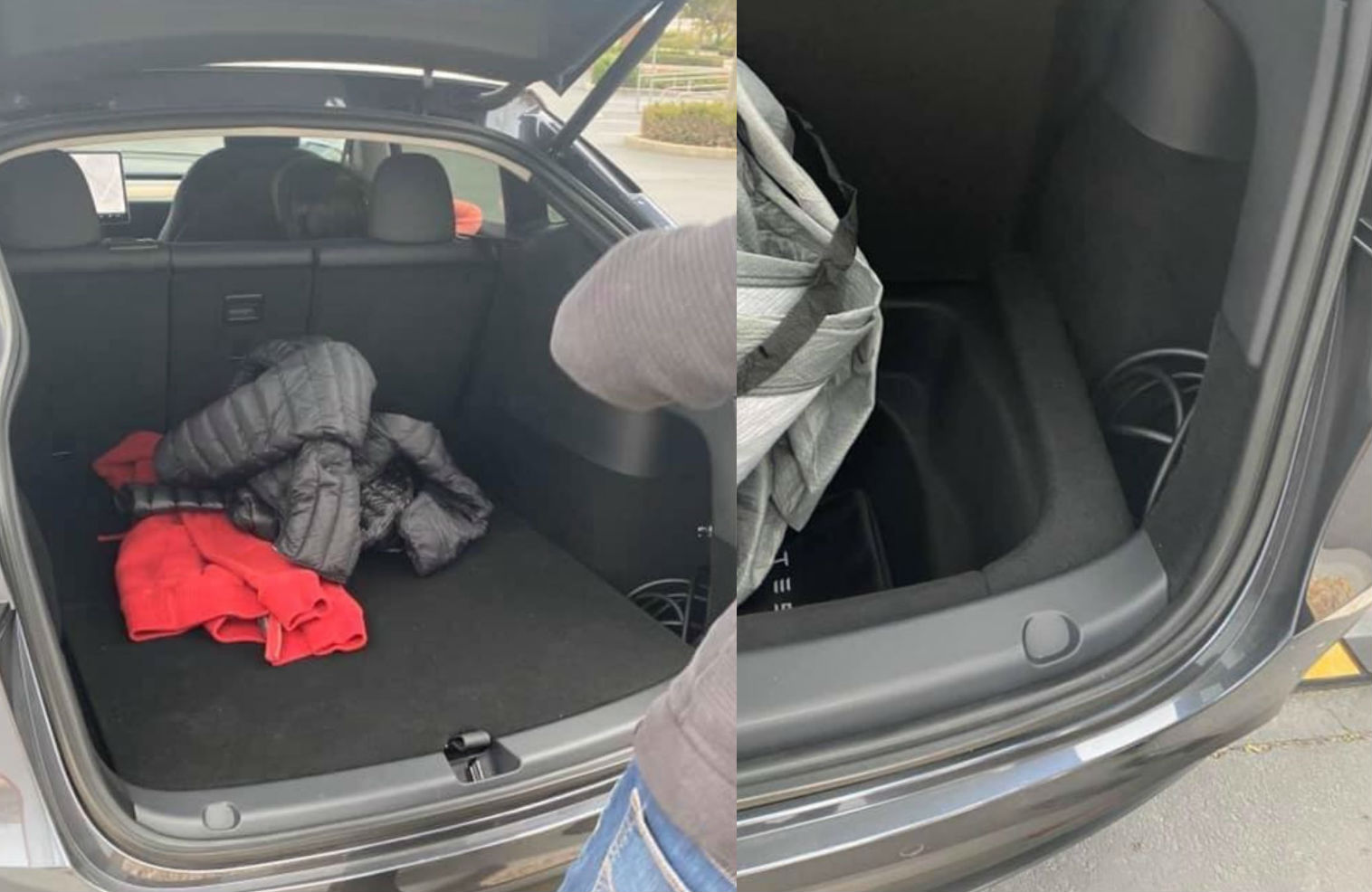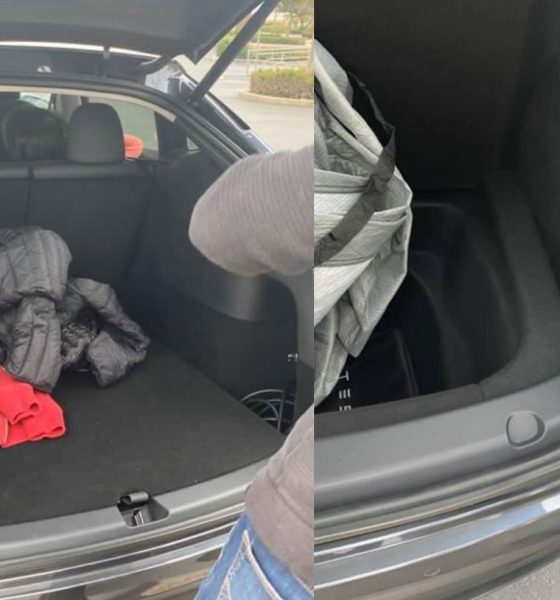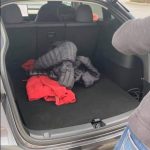

News
Tesla Model Y has rear cargo space that’s more Model X than Model 3
Recent images of a Tesla Model Y release candidate with its rear hatch open has provided a small teaser of the upcoming all-electric crossover’s rear cargo space. Based on the photos, it appears that the Model Y’s primary luggage area is very generous, to the point where it almost seems comparable to that of the larger Tesla Model X. This is quite impressive, especially considering that the Model Y shares 75% of its parts with the Model 3 sedan, which is far smaller than the Model X.
The new pictures were shared on the Tesla Model Y Enthusiasts Facebook page, with members Thomas Andre Davik and Josh Jones sharing a couple of new shots from a recent Model Y sighting. Fortunately, the two Tesla enthusiasts were able to capture a photo of the vehicle with its open rear hatch, showing how much cargo space is available when the second row seats are up.
- Tesla Model Y trunk (Source: Thomas Andre Davik | Model Y Enthusiast Facebook Page)
- Tesla Model Y extra storage under main trunk(Source: Josh Jones | Model Y Enthusiast Facebook Page)
The Tesla Model Y with rear hatch open. (Credit: Thomas Andre Davik and Josh Jones/Facebook)
Immediately noticeable from the images was the fact that the Model Y’s luggage area is quite large. Surprisingly large, in fact, even without its additional storage space underneath the trunk itself. An image of this additional storage area shows that it is quite deep as well, possibly fitting a couple of extra bags during long drives.
Reactions from the Tesla community show that the Model Y’s cargo space may end up being a key selling point for the upcoming vehicle. Tesla Model X 90D owner and r/TeslaMotors subreddit member u/kenriko noted that the Model Y’s luggage space looks comparable in utility as his vehicle’s cargo area with its third row folded. Fellow Tesla enthusiast Christopher Pichner also remarked that the Model Y’s design makes for a cargo area that looks more usable than his 2018 Subaru Forester, which lists a 76 cu ft of luggage space versus the Model Y’s 66 cu ft.

These observations, while only based on a couple of new photos of the Model Y, bodes well for the upcoming all-electric crossover, as it suggests that Tesla is pretty much optimizing the vehicle’s utility as much as possible, making it more attractive to the mainstream crossover market. The comparisons to the Model X’s cargo space are quite impressive too, considering that the Model Y shares most of its parts with Tesla’s smallest vehicle today, the Model 3.
As the Model Y nears its first deliveries, it is becoming more and more evident that the vehicle is designed to disrupt an established auto market. Apart from its competitive price, the Model Y has the performance to match, with its top-tier version being capable of sprinting from 0-60 mph in 3.5 seconds. The Model Y also has a middle row pass-through feature that will allow owners to transport long items like skis without any issues. Together with a seemingly very generous trunk space, these little details may very well prove to be among the reasons why the Model Y may eventually start eating into the market of mainstream vehicles like the Honda CR-V and the Toyota RAV-4, much like the Model 3 and more affordable cars like the Toyota Corolla and the Honda Accord.

Elon Musk
Elon Musk’s X will start using a Tesla-like software update strategy
The initiative seems designed to accelerate updates to the social media platform, while maintaining maximum transparency.

Elon Musk’s social media platform X will adopt a Tesla-esque approach to software updates for its algorithm.
The initiative seems designed to accelerate updates to the social media platform, while maintaining maximum transparency.
X’s updates to its updates
As per Musk in a post on X, the social media company will be making a new algorithm to determine what organic and advertising posts are recommended to users. These updates would then be repeated every four weeks.
“We will make the new 𝕏 algorithm, including all code used to determine what organic and advertising posts are recommended to users, open source in 7 days. This will be repeated every 4 weeks, with comprehensive developer notes, to help you understand what changed,” Musk wrote in his post.
The initiative somewhat mirrors Tesla’s over-the-air update model, where vehicle software is regularly refined and pushed to users with detailed release notes. This should allow users to better understand the details of X’s every update and foster a healthy feedback loop for the social media platform.
xAI and X
X, formerly Twitter, has been acquired by Elon Musk’s artificial intelligence startup, xAI last year. Since then, xAI has seen a rapid rise in valuation. Following the company’s the company’s upsized $20 billion Series E funding round, estimates now suggest that xAI is worth tens about $230 to $235 billion. That’s several times larger than Tesla when Elon Musk received his controversial 2018 CEO Performance Award.
As per xAI, the Series E funding round attracted a diverse group of investors, including Valor Equity Partners, Stepstone Group, Fidelity Management & Research Company, Qatar Investment Authority, MGX, and Baron Capital Group, among others. Strategic partners NVIDIA and Cisco Investments also continued support for building the world’s largest GPU clusters.
News
Tesla FSD Supervised wins MotorTrend’s Best Driver Assistance Award
The decision marks a notable reversal for the publication from prior years, with judges citing major real-world improvements that pushed Tesla’s latest FSD software ahead of every competing ADAS system.

Tesla’s Full Self-Driving (Supervised) system has been named the best driver-assistance technology on the market, earning top honors at the 2026 MotorTrend Best Tech Awards.
The decision marks a notable reversal for the publication from prior years, with judges citing major real-world improvements that pushed Tesla’s latest FSD software ahead of every competing ADAS system. And it wasn’t even close.
MotorTrend reverses course
MotorTrend awarded Tesla FSD (Supervised) its 2026 Best Tech Driver Assistance title after extensive testing of the latest v14 software. The publication acknowledged that it had previously criticized earlier versions of FSD for erratic behavior and near-miss incidents, ultimately favoring rivals such as GM’s Super Cruise in earlier evaluations.
According to MotorTrend, the newest iteration of FSD resolved many of those shortcomings. Testers said v14 showed far smoother behavior in complex urban scenarios, including unprotected left turns, traffic circles, emergency vehicles, and dense city streets. While the system still requires constant driver supervision, judges concluded that no other advanced driver-assistance system currently matches its breadth of capability.
Unlike rival systems that rely on combinations of cameras, radar, lidar, and mapped highways, Tesla’s FSD operates using a camera-only approach and is capable of driving on city streets, rural roads, and freeways. MotorTrend stated that pure utility, the ability to handle nearly all road types, ultimately separated FSD from competitors like Ford BlueCruise, GM Super Cruise, and BMW’s Highway Assistant.
High cost and high capability
MotorTrend also addressed FSD’s pricing, which remains significantly higher than rival systems. Tesla currently charges $8,000 for a one-time purchase or $99 per month for a subscription, compared with far lower upfront and subscription costs from other automakers. The publication noted that the premium is justified given FSD’s unmatched scope and continuous software evolution.
Safety remained a central focus of the evaluation. While testers reported collision-free operation over thousands of miles, they noted ongoing concerns around FSD’s configurable driving modes, including options that allow aggressive driving and speeds beyond posted limits. MotorTrend emphasized that, like all Level 2 systems, FSD still depends on a fully attentive human driver at all times.
Despite those caveats, the publication concluded that Tesla’s rapid software progress fundamentally reshaped the competitive landscape. For drivers seeking the most capable hands-on driver-assistance system available today, MotorTrend concluded Tesla FSD (Supervised) now stands alone at the top.
News
Elon Musk’s Grokipedia surges to 5.6M articles, almost 79% of English Wikipedia
The explosive growth marks a major milestone for the AI-powered online encyclopedia, which was launched by Elon Musk’s xAI just months ago.

Elon Musk’s Grokipedia has grown to an impressive 5,615,201 articles as of today, closing in on 79% of the English Wikipedia’s current total of 7,119,376 articles.
The explosive growth marks a major milestone for the AI-powered online encyclopedia, which was launched by Elon Musk’s xAI just months ago. Needless to say, it would only be a matter of time before Grokipedia exceeds English Wikipedia in sheer volume.
Grokipedia’s rapid growth
xAI’s vision for Grokipedia emphasizes neutrality, while Grok’s reasoning capabilities allow for fast drafting and fact-checking. When Elon Musk announced the initiative in late September 2025, he noted that Grokipedia would be an improvement to Wikipedia because it would be designed to avoid bias.
At the time, Musk noted that Grokipedia “is a necessary step towards the xAI goal of understanding the Universe.”
Grokipedia was launched in late October, and while xAI was careful to list it only as Version 0.1 at the time, the online encyclopedia immediately earned praise. Wikipedia co-founder Larry Sanger highlighted the project’s innovative approach, noting how it leverages AI to fill knowledge gaps and enable rapid updates. Netizens also observed how Grokipedia tends to present articles in a more objective manner compared to Wikipedia, which is edited by humans.
Elon Musk’s ambitious plans
With 5,615,201 total articles, Grokipedia has now grown to almost 79% of English Wikipedia’s article base. This is incredibly quick, though Grokipedia remains text-only for now. xAI, for its part, has now updated the online encyclopedia’s iteration to v0.2.
Elon Musk has shared bold ideas for Grokipedia, including sending a record of the entire knowledge base to space as part of xAI’s mission to preserve and expand human understanding. At some point, Musk stated that Grokipedia will be renamed to Encyclopedia Galactica, and it will be sent to the cosmos.
“When Grokipedia is good enough (long way to go), we will change the name to Encyclopedia Galactica. It will be an open source distillation of all knowledge, including audio, images and video. Join xAI to help build the sci-fi version of the Library of Alexandria!” Musk wrote, adding in a later post that “Copies will be etched in stone and sent to the Moon, Mars and beyond. This time, it will not be lost.”










